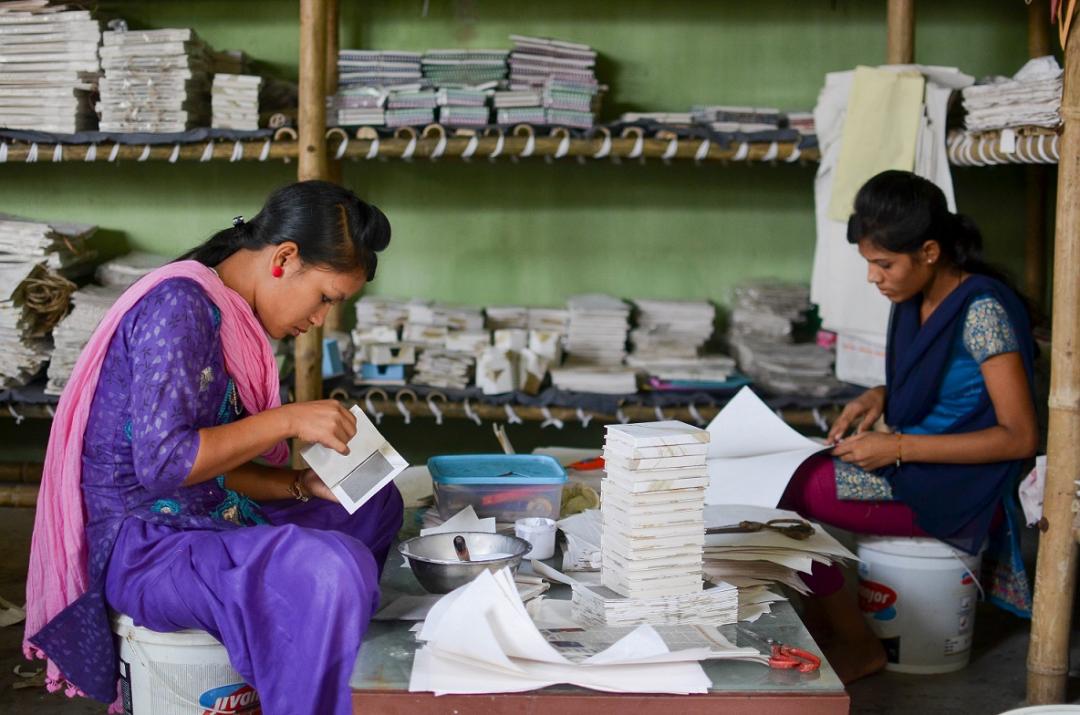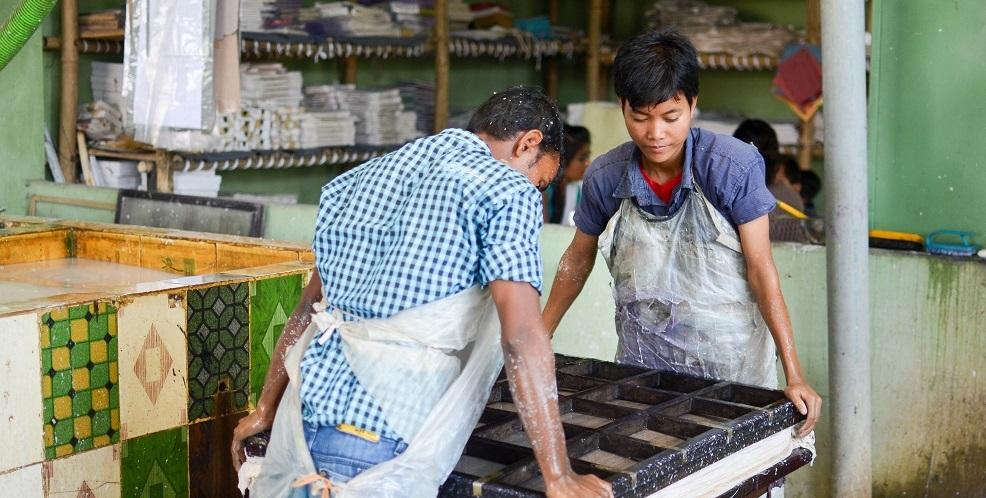How early-stage investment helps entrepreneurs create meaningful jobs for India’s poorest communities
Upaya Social Ventures creates dignified jobs by partnering with early-stage entrepreneurs to scale their businesses, employing more people in their communities. The businesses Upaya works with are often too large for micro-loans, but their business models are not yet suitable for investments from local banks or venture capitalists due to the risk involved and support needed. Through its investments and accelerator program, Upaya helps entrepreneurs grow their businesses and create jobs that lift families out of extreme poverty.
Why did Upaya Social Ventures decide to invest in entrepreneurs creating employment for underserved communities in India?
Upaya was founded in 2011 by three cofounders who had all met working in microfinance. What they observed in that work is that, while financial inclusion for the poor had many benefits and was reaching millions of people, there was a segment of the population, the “ultra-poor” for whom microfinance was not well suited. Taking out loans was too risky for this very vulnerable population.
However our cofounders had seen the enormous scale that microfinance had demonstrated by tapping into market forces rather than a subsidy model. After studying the issue and looking at the best in class offerings to reach this segment, they concluded that there was a market-oriented way to help lift people out of extreme poverty. They believed that there were entrepreneurs who shared this vision but were being overlooked by traditional investors. So they launched Upaya with the business model of being early stage investors in companies that could provide meaningful and dignified jobs that enabled families to rise above extreme poverty. We selected India because of the entrepreneurial vibrancy there as well as the obvious poverty.
How did Upaya’s early investments foster follow-on investments for these inclusive businesses?
Upaya explicitly sees our role as identifying overlooked but promising enterprises and helping to de-risk them for later investors. In most cases, we are the first institutional investor to support the enterprise. We come in when there is proof of demand for their product or service, but they may not have perfect product market fit. We view our role as helping the enterprise to refine and execute on their scale model and then preparing them for later rounds of investment. We actively promote our portfolio companies to other investors in our network when we feel they are ready to raise their next round. Our current ratio of follow-on investment is 4X our investment.
Looking beyond the impact on our own portfolio, however, Upaya sees an opportunity to help solve the funding gap for “missing middle” companies. These are the companies that are too large for microfinance but too small for traditional investors. They may not be Silicon Valley rocket ships, but they are solid companies that, with early and catalytic investment, can become major drivers of their local economies and meaningful job creators. We want to demonstrate these companies are very investable.

Image provided by the interviewee.
In your view, why is it important to identify and finance new solutions to environmental and social problems, as you do through the Accelerator Program? How do you identify gaps where investments can provide high levels of impact?
The environmental and social problems that affect us all are vast and can be overwhelming. We cannot pigeonhole solving these problems into the work of the public sector or nonprofits. Upaya firmly believes in the potential of harnessing market forces to have massive impact on poverty, on climate change, on gender inequality, and the list goes on. If the private sector steps up and embraces these challenges and builds new business models that incorporate solutions to these problems in viable business models, we can turbocharge our progress. This is not theoretical. Financial inclusion was a pipe dream and the province of philanthropies 30 years ago. Now most of the world has access to a bank account.
While our primary impact metric is livelihood generation, we also consider a company’s impact on the environment. We are excited to invest in companies that are having a beneficial impact, especially on climate change. We have just made an investment into a company that uses drone technology and heat mapping to help farmers identify pest infestations earlier to be able to eradicate the pests using environmentally friendly methods. This is a great example of a company that is increasing the income of farmers while also improving their environmental impact.
In terms of how we identify gaps, we focus on livelihood generation, especially in areas with limited economic opportunity. We are very proud of the fact that half of our investment dollars have flowed to Indian states that are considered underserved.
Do you think investors are seeking out new business models that have a social impact? Can inclusive businesses provide an alternative for investors because their social impact is part of the business model?
Certainly there is evident demand for investment opportunities that have social impact. I believe the current statistic is that $1 out of four is going into “ESG” investments. Inclusive businesses absolutely can meet the need of investors to achieve a reasonable return while also producing positive results on social goals.

What advice would you have for entrepreneurs who are having trouble explaining their value to investors because they have unique inclusive business models?
We often meet with entrepreneurs who select their industry or segment because they want to have a broad impact on, for example, food quality. There’s nothing wrong with that but if they cannot communicate a more compelling and specific vision of how their company is going to create value and social impact where it wasn’t before, it is hard to imagine that they have really built a business model to focus on that. At the same time, I don’t believe that social entrepreneurs should feel at all apologetic that they are balancing more than just the profit motive. Social enterprises can be profitable and scalable as well as impactful.
I do think that some of the earliest voices in the impact investing industry may have done a disservice to those of us who are impact first investors by promising investors that they can do well and do good. That is certainly the case sometimes, but sometimes it is the right thing to do good and to do well enough. Not every impact investment needs to have a full market rate, risk-adjusted return. That is why we source our capital from philanthropies through recoverable grants. The work we do is very high risk but also very high impact. We believe that by returning capital and a small return on top of that, we are filling a useful part of the capital spectrum for high impact but lower than market rate opportunities.
As the number of ESG and climate-themed funds has increased, so too have concerns about “greenwashing” and transparency. How important is measuring impact to mitigating “ESG-washing”or “greenwashing”?
I believe that the interest in ESG and climate themed funds is highly welcome, but also carries great risk while we as an industry have not aligned on clear standards and methodologies for assessing impact. There has been tremendous progress with the Impact Management Project and other initiatives. We are moving in the right direction, but there’s still a lot of ambiguity. There is very high risk that in this environment, anyone can claim impact without doing the work to ensure that it is happening. Or even ensuring that there isn’t harm happening.
We at Upaya spend about 15 percent of our operating budget on our impact management and measurement. While that may seem like a high proportion of our resources, we don’t think of it as a cost of reporting to donors or marketing material. It is money invested in quality control and research & development. This is the data that helps us refine our investment thesis or helps us guide an entrepreneur to have greater impact than they currently might be having. We are often told that we are doing deeper impact measurement than many of the much larger funds. While I’m proud of what we do, I would encourage others to reexamine their priorities – and I do think that’s beginning to happen.
